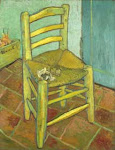
It's not every day the world gets a new van Gogh painting.
Oh, sure, there are folks who *think* they have an original van Gogh, but thinking you have one and having one are two different things. These days, the official imprimaturs come from the good scholars of the Van Gogh Museum, and although they probably get many, many authentication requests, only once in a blue moon do they hit the jackpot.
Dutch art collector Dirk Hannema thought his "Le Blute-Fin" (AP Photo/Fundatie de Zwolle, click to enlarge) was a real van Gogh -- he thought so for 35 years. And finally, for the first time since 1995, the VGM has authenticated a never-before-catalogued van Gogh. Louis van Tilborgh, research curator at the VGM, did the honors. According to the Associated Press article published today, van Tilborgh cites the stamp on the back of the canvas, from a Paris art store Vincent frequented, and the types of pigments used in the painting as evidence for authenticity. Research on pigments is relatively new business, new enough that a forger working long enough ago for Hannema to acquire the painting wouldn't have known what to fake. Van Tilborgh dates the painting to Vincent's Paris period and more specifically to the year 1886. This is not a surprise, for not only does the painting show a Parisian landmark -- the Blute-Fin windmill in Montmartre -- but Vincent painted this windmill several times. This image of "Le Moulin de Blute-Fin" (F273), for instance, is dated to summer 1886. The one closest in composition to the "new" painting is this one (F271),which (alas) was destroyed by fire in 1967. The big difference between the latter painting and the new picture, though, is the amount of figures. Rather uncharacteristically for van Gogh's work, especially at this point, the stairway in the new painting is crowded with people. Not only that, but the people are shown closer in than was typical for him: compare for instance this painting (F272, in the Art Institute of Chicago),where the figures on the observation deck of the Blute-Fin are standing at some distance from the artist. In the 'new' painting, no doubt it was the figures that kept this canvas in the "doubtful" category for so long, until the technology evolved for the examination of the pigments. In fact, while I don't claim to be nearly the expert as the VGM curators, if you'd shown me this picture and asked "Real? Not real?" I would have voted "Not Real" because of the figures.
So what was Le Blute-Fin? In Vincent's day, three windmills still stood on the hill of Montmartre, nostalgic leftovers from the days when the landscape was peppered with them. One of them was actually nicknamed the Peppermill (aka the Debray), then there was le Radet and le Blute-Fin. Vincent's early Paris canvases show many views of Montmartre and his new home, but as a Dutchman, no doubt he had a particular attraction to the windmills. Le Blute-Fin was built in 1622 and was perhaps better known in Vincent's day as "Le Moulin de la Galette," a nickname it shared with Le Radet. Together these two windmills anchored the famous dance-hall painted by Renoir, Toulouse-Lautrec, and Vincent himself [van Gogh only painted the exterior though]. The Blute-Fin was also noteworthy for its "point de vue," its panoramic view down to Paris from its belvedere, or observation deck. In the foreground of Vincent's 'new' picture we probably see a stand for buying a beer or lemonade, and the figures crowding the stairs are beautifully dressed in seemingly Sunday best, enjoying a walk on a pleasant afternoon.
The new van Gogh is on view at the Fundatie de Zwolle in Zwolle, the Netherlands.






No comments:
Post a Comment